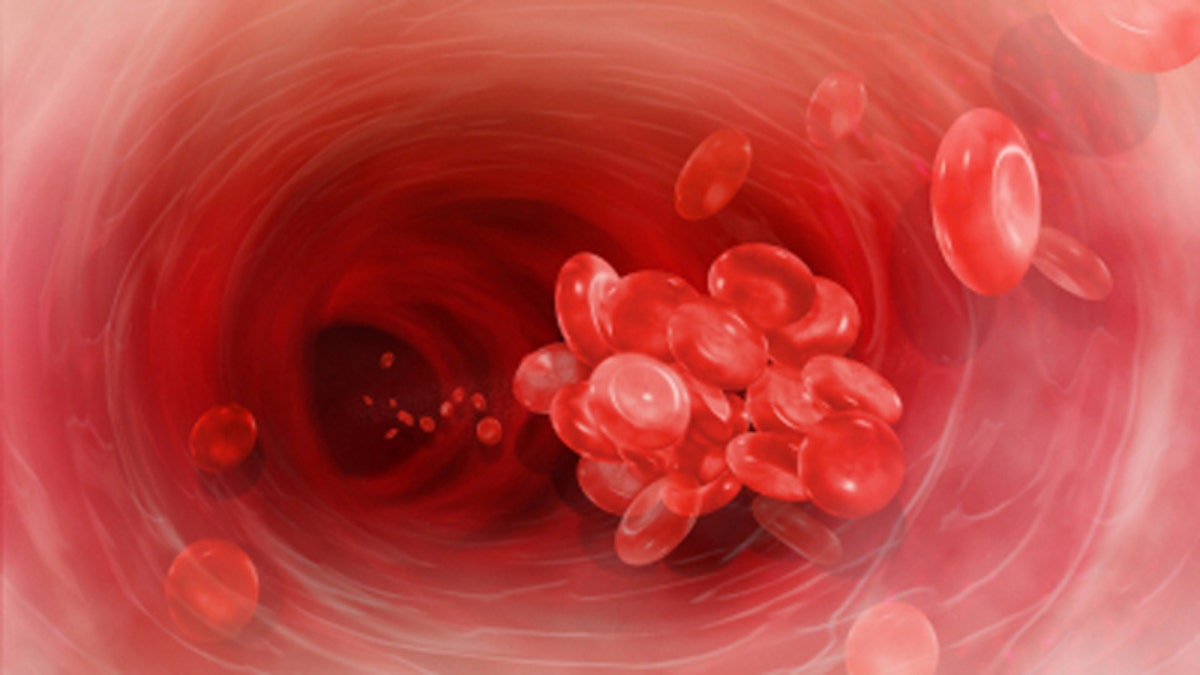
(iStock)
Blood clots happen in your body all the time. When you skin your knee or cut yourself on a knife, your blood thickens around the area of the wound until your skin can start repairing itself. It’s a miraculous process.
Like any other function of the body, though, the blood clotting can happen at unusual times. Unwanted clotting can even cause problematic and even life-threatening situations.
HEART DISEASE: LEARN THE FACTS
So what exactly causes a blood clot to form? First, you should understand a few major types of clots and the symptoms that accompany them.
Types of Blood Clots
1. Deep vein thrombosis
One of the most dangerous types of blood clots is deep vein thrombosis, a clot that forms within one of the major veins of the body. Usually, people experience DVT in the lower leg.
While experts do not know the exact number of cases, estimates for DVT go as high as 900,000 people each year, according to the CDC. Of these, an estimated 60,000 to 100,000 will eventually die from the blood clot or subsequent pulmonary embolism (PE).
Symptoms: Swelling, general or localized discoloration, a warm sensation and tenderness or aching pain. Again, many cases of DVT start in the lower leg. You should also note that some people don’t experience any symptoms when dealing with DVT.
2. Pulmonary Embolism
A pulmonary embolism happens when a blood clot forms or, most commonly, travels to the arteries in the lungs. This type of blood clot is also extremely dangerous because it blocks blood flow to the lungs.
Many people suffer complications or death due to pulmonary embolism, even if the blood clot formed in another area first. If you’re experiencing any of the following symptoms, you should seek immediate medical attention.
WOMAN LOSES BOTH HANDS, LEGS AFTER SEPSIS BATTLE
Symptoms: Shortness of breath or difficulty breathing, chest pain, coughing that may produce blood, feeling of weakness or dizziness.
3. Heart Attack
Next, a blood clot can also form or travel to the heart, blocking blood flow and leading to a dangerous heart attack. In this case, many symptoms mimic a pulmonary embolism because of its location. Either way, get medical help immediately.
Symptoms: Severe chest pain, pain that extends to the arms, back, neck or jaw, shortness of breath, overall weakness or dizziness
4. Stroke
Then, a clot that blocks blood flow to the brain can instigate a stroke in an otherwise healthy person. This blood clot can be caused by injuries to the head, such as a concussion, or by fatty deposits in the blood vessel walls.
Symptoms include: Speech changes or difficulty speaking, headaches, paralysis, dizziness or seizures.
What Causes a Blood Clot?
As mentioned above, blood clots usually form when you sustain an injury. They help to stop the bleeding so that you do not lose too much blood.
IS YOUR THYROID SLEEPING ON THE JOB?
Sometimes, however, the blood may thicken or coagulate due to other factors. Also, blood clots can cause danger when they perform their job for an injury but do not dissolve right away. Here are a few factors that cause blood clots to form unnecessarily:
- Pregnancy – An expectant mother’s body actually increases the volume of blood, leading to a higher risk for blood clots.
- Obesity – Obesity can slow the rate of blood flow in the veins.
- Family history
- Smoking – Smoking causes damage to the lining of blood vessels and increases the chances that platelets will stick together.
- Cancer – Cancer may increase risk due to chemotherapy damage or a decrease in protective proteins.
- Immobility – Many people develop blood clots during a time of immobility such as bed rest or long trips. During this period, the legs are not moving and thus unable to keep blood pumping through them.
How to Prevent Blood Clots
First and foremost, you should keep moving throughout the day to keep blood clots from forming. If you work at a desk job or have a long trip ahead, stand up and move around every 1–2 hours. Performing toe lifts or simple desk exercises can help as well.
In addition, you can develop blood clots even during normal resting periods; so be sure to follow the same rules even when you’re watching TV or relaxing on the weekend. While you sleep, you can also raise the foot of your bed or rest your feet on a pillow to keep the blood from pooling.
Then, you should maintain a healthy exercise routine and weight management to reduce your risk in these areas. Throughout all of your activity, be sure to drink plenty of water, increasing your intake during trips, exercise or hot weather.
You should do all you can to reduce your risk of blood clots if you fall under one of the other risk categories, such as having a family history. These simple tips can ward off unwanted blood clots while keeping you healthy and active.
This article first appeared on AskDrManny.com.




















